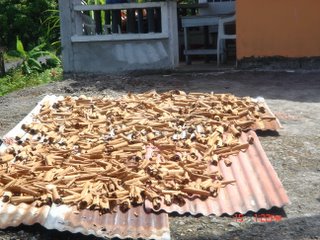Although you may not recognize it this is cinnamon bark drying in the sun. You cut the tree down, cut the limbs into manageable sizes , then skin off the outer, grayish bark and cut off this layer. It is then left to dry in the sun, often on a piece of tin as it is here. Cinnamon bark can sell for as much as $8 EC ($3 US) a pound, but of course you have to kill the tree to get it.
, then skin off the outer, grayish bark and cut off this layer. It is then left to dry in the sun, often on a piece of tin as it is here. Cinnamon bark can sell for as much as $8 EC ($3 US) a pound, but of course you have to kill the tree to get it.
 , then skin off the outer, grayish bark and cut off this layer. It is then left to dry in the sun, often on a piece of tin as it is here. Cinnamon bark can sell for as much as $8 EC ($3 US) a pound, but of course you have to kill the tree to get it.
, then skin off the outer, grayish bark and cut off this layer. It is then left to dry in the sun, often on a piece of tin as it is here. Cinnamon bark can sell for as much as $8 EC ($3 US) a pound, but of course you have to kill the tree to get it. As you may have guessed agriculture in the Caribbean is not like in Kansas or Illinois or even Florida. Many of the islands are mountainous and so it's impossible to farm with machinery. The soil is usually fertile but there is no cool temperature, except because of altitude, so the range of crops that can be grown is limited. Because of the year round warm weather nobody cans or freezes--it's available most of the time.
Many of the crops grown are root crops--dasheen, tania, yams of several kinds (don't think sweet potatoes, but rather the white ones usually called yuca in the States). There are also plaintains and a number of different bananas, some miniature, some starchy & fat, besides what you think of as bananas. Contrary to the way we use bananas, they are most often cooked green--boiled or fried and taste more like a potato than a "banana". This would be the staple of many meals if things are normal.
Fruits are available, but only seasonally. Apples, pears, peaches, etc. will not grow in the tropics, but they are replaced by oranges, grapefruits, limes, mangos, pineapples, and one of my favorites, passion fruit (no, not that kind of passion). In Dominica most of these trees are old and often on community land, so whoever picks them can eat them--not much market to sell them, as when it is grapefruit season everybody has grapefruit etc.
Spices is where what little money there is in agriculture is anymore. There was a time that Britain bought bananas at a premium price, to help support the islands, but that was declared "illegal" by the WTO so bananas bring almost nothing. Coconuts used to be dried and used in soap and other products, but that too has pretty well dried up now. Cinnamon is harvested throughout the E. Caribbean. The island of Grenada is known as the "Spice Island" because of the many wild spice trees there--nutmeg, cloves, cinnamon. Allspice, mace, and nutmeg all come from the nutmeg, so it is the major spice there. Ginger is also grown extensively throughout the islands. Many people have a few coffee bushes and perhaps a cocoa tree as well, but mostly for local use.
Generally speaking, agriculture is not to make a living at, but to supply your own food. With the year round growing season most people have enough to eat and are blessed to have a place to stay, the clothes they need, and make it.
Tol Burk

No comments:
Post a Comment